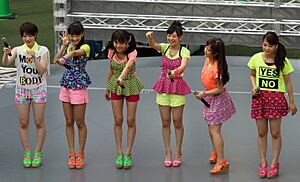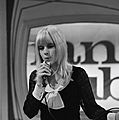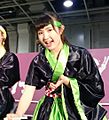Japanese idol facts for kids


In Japanese pop culture, an idol is a young star. These stars are usually admired for their cuteness. Idols are meant to be role models for young people. They try to keep a good public image.
Idols do many things in the media. They can be pop singers, actors, or models. They also appear on TV shows and in advertisements. Japanese talent agencies find these young stars. They hold auditions for talented boys and girls. Then, they help them become famous.
Fans often love idols very much. Some people in Japan see idols like a younger sister or a friend next door. Japanese idol singers perform many types of Japanese pop music. Their songs are usually what is popular at the moment. Idols do not always need amazing singing skills. But they must be beautiful, sweet, and kind. They also need to have a perfect public image.
The biggest yearly idol concert is the Tokyo Idol Festival (TIF). It has been held since 2010. In 2017, over 200 idol groups performed. About 1500 idols took part, and more than 80,000 fans watched.
The History of Japanese Idols
The idea of idols started in the early 1970s. This was partly because of a young French actress named Sylvie Vartan. She was very popular in Japan. Her movie, Cherchez l'idole ("Look for the Idol"), came out in Japan in 1964. It was called Aidoru o Sagase.
After this, the word "idol" began to be used. It described young girls, often 14 to 16 years old. These girls were just starting their journey to become stars. It also referred to very young new stars.
Famous Japanese Idols and Groups
Many idols and idol groups have become very famous. They have sold millions of records. Some of the most well-known include Seiko Matsuda and Akina Nakamori. Groups like AKB48 and Momoiro Clover Z are also very popular. These artists have helped shape Japanese pop music.
Images for kids
-
AKB48 (pictured 2010) popularized stylized school uniforms as costumes.
-
Nana Mizuki (pictured 2018) was one of the first voice actors marketed as an idol.
-
Dempagumi.inc (pictured 2015) is an Akiba-kei idol group, with music and performances influenced by the otaku culture in Akihabara.
-
Perfume (pictured 2015) began as a local idol group performing in Hiroshima.
-
Sylvie Vartan (pictured 1966) is the codifier of the term "idol", after her appearance in the film Cherchez l'idole (1964) was well-received in Japan.
-
Akina Nakamori (pictured 1985) is one of the idols defining the 1980s, the Golden Age of Idols.
-
Namie Amuro (pictured 2017) saw popularity among girls in the 1990s, despite rejecting the idol label.
-
Hitomi Honda interacts with a fan at an AKB48 handshake event in 2017.
-
Minami Minegishi (pictured 2009) made international news in 2013 after a video of her with a shaved head as penance went viral. This followed news reports suggesting she was in a relationship, which led to her demotion in AKB48.
See also
 In Spanish: Idol japonés para niños
In Spanish: Idol japonés para niños














